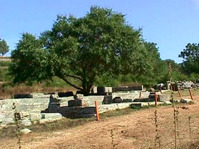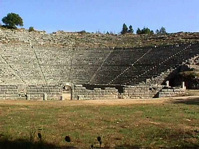Ancient Dodoni
The interest of finding lost Dodoni started by the mentions for Dodoni of: Aeschylus, Sophocles, Platon, Homer, Hesiod and others, but also from the legends of the tradition. In 1875 an excavation took place at the location between Manoliasa and Olytsikas (Tomaros), 22 km. southwest to the city of Ioannina.
The research took place under the supervision of K. Karapanos who discoverd the temple of Zeus (the holy house) with findings from the copper age. Prehistoric vessels, weapons, brooches, coins, bracelets, signs, resolutions, statues, etc. are the first findings that are exhibited at the Archaeological Museum of Athens. Other excavations took place after the year of 1913 by G. Sotiriadis and Evagelidis in 1925 – 1935.
During the decade of 1950 an organised research takes place (by Evagelidis – Dakaris and Dakaris – Mouselimis) which brings to the surface the theatre and many findings (vessels, statues, coins) that are exhibited at the ΑArchaeological Museum of Ioannina. The archaeological company and the University of Ioannina reconstructed the theatre and the stadium.
Homer’s poets are the oldest testimonies for Dodoni, where at the beggining Earth goddess was worshiped (3.000 B.C.) to whom sacrifised the holy bull for a fertile land. Selloi (a race from Thesprotia) who lived in Ellopia established the worship of Zeus and Dryo (1900 – 1400 B.C.).
Vessels on tripods around the holy oak tree (PHYGOS), priests and priestesses (prophets, seeks) who live in huts, sleep on the ground so as to become one with Earth is the image of the ancient oracle.
They predict the future according to the rustle of the leaves of the oak, the whistling of the pigeons that live on the holy tree and the sound of the water flow of holy spring.
The seers beleived that one of the two goddesses of Thiva in Egypt, that was taken by the Phoenicians, came here like a pigeon on the braches of PHYGOS and asked with a human voice to become this place an oracle. They also believed that Zeus and Earth goddess (who later renamed to Dioni), lived under the branches of the holy tree.
The construction of the buildings in the region started on the 4th century B.C., the temple of Zeus (with supplemental bulidings finished on the 2nd century B.C.) The theatre one of the biggest in Greece, of 18.000 seats, was built on the 3rd century B.C. by king Pyrros. The parliament buliding on the 3rd – 4th century B.C. The prytaneum is the most ancient building after the holy house where they stayed the priests of Zeus or the rulers of the “Common of Molossoi”.
The cittadel of the settlement with a polygonal wall which is located on the top of the hill was built on the 4th century B.C. The wall and the temples of Hercules and Dioni were built by king Pyrros. After the year of 300 B.C king Pyrros created the religion of Molossoi (Olympian Gods), built the theatre and organised Naia and other athletic events every four years (sacrifices, running and other spotrs events).
All these buildings were destroyed a lot of times: By the Aitolians in 219 B.C. and are rebuilt by Philip B’, the king of Macedonia. In 167 B.C. was destroyed again by Aimilios Paul of Rome (August rebuilt it once again and uses the theatre as an arena).
During the period of Theodosios the Great in 391 A.D. the holy tree is cut, the oracle closes and two christian churches are built. Two more destructions follow and the habitants abandon the place of Dodoni.
Nowadays, every summer, the place revives with perfomances of anciene drama and comedies that are played with great success.






